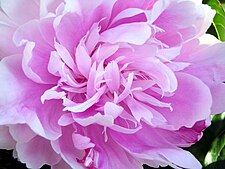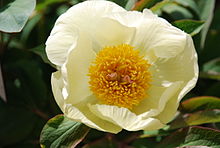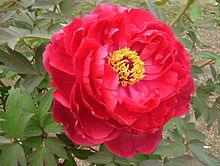China currently has no official national flower. Traditionally, various regions have different designations where national symbols are concerned. In 1903, the Qing Dynasty named the peony (Paeonia suffruticosa) the floral emblem of the nation. The peony has long been considered a flower of wealth and honor in China.
The plum blossom meihua (Chinese: méihuā) has been long held as one of the most beloved flowers in Chinese culture. The Republic of China government named the plum blossom as the national flower in 1964. The plum blossom is symbol for resilience and perseverance in the face of adversity, because plum blossoms often bloom most vibrantly even amidst the harsh winter snow.
 The People's Republic of China, which has controlled mainland China since 1949, has no official floral emblem. There have been several petitions in recent years to officially adopt one. However, the government has not taken any action yet. A poll in 2005 showed that 41% of the public supports peony as the national flower while 36% supported the plum blossom. Some scholars have suggested that the peony and plum blossoms may be designated as dual national flowers. The orchids and chrysanthemum have also been held as possible floral symbols of China, along with the peony and plum blossoms.
The People's Republic of China, which has controlled mainland China since 1949, has no official floral emblem. There have been several petitions in recent years to officially adopt one. However, the government has not taken any action yet. A poll in 2005 showed that 41% of the public supports peony as the national flower while 36% supported the plum blossom. Some scholars have suggested that the peony and plum blossoms may be designated as dual national flowers. The orchids and chrysanthemum have also been held as possible floral symbols of China, along with the peony and plum blossoms.Peony or paeony is a name for plants in the genus Paeonia, the only genus in the flowering plant family Paeoniaceae. They are native to Asia, southern Europe and western North America. Boundaries between species are not clear and estimates of the number of species range from 25 to 40.
 Most are herbaceous perennial plants 1.5 - 5 feet (0.5 - 1.5 metres) tall, but some resemble trees up to 5 - 10 feet (1.5 – 3 metres) tall. They have compound, deeply lobed leaves, and large, often fragrant flowers, ranging from red to white or yellow, in late spring and early summer. The peony is named after Paeon (also spelled Paean), a student of Asclepius, the Greek god of medicine and healing. Asclepius became jealous of his pupil; Zeus saved Paeon from the wrath of Asclepius by turning him into the peony flower.
Most are herbaceous perennial plants 1.5 - 5 feet (0.5 - 1.5 metres) tall, but some resemble trees up to 5 - 10 feet (1.5 – 3 metres) tall. They have compound, deeply lobed leaves, and large, often fragrant flowers, ranging from red to white or yellow, in late spring and early summer. The peony is named after Paeon (also spelled Paean), a student of Asclepius, the Greek god of medicine and healing. Asclepius became jealous of his pupil; Zeus saved Paeon from the wrath of Asclepius by turning him into the peony flower. The family name "Paeoniaceae" was first used by Friedrich K.L. Rudolphi in 1830, following a suggestion by Friedrich Gottlieb Bartling that same year. The family had been given other names a few years earlier. The composition of the family has varied, but it has always consisted of Paeonia and one or more genera that are now placed in Ranunculales. It has been widely believed that Paeonia is closest to Glaucidium, and this idea has been followed in some recent works. Molecular phylogenetic studies, however, have demonstrated conclusively that Glaucidium belongs in Ranunculaceae, but that Paeonia belongs in the unrelated order Saxifragales.
The family name "Paeoniaceae" was first used by Friedrich K.L. Rudolphi in 1830, following a suggestion by Friedrich Gottlieb Bartling that same year. The family had been given other names a few years earlier. The composition of the family has varied, but it has always consisted of Paeonia and one or more genera that are now placed in Ranunculales. It has been widely believed that Paeonia is closest to Glaucidium, and this idea has been followed in some recent works. Molecular phylogenetic studies, however, have demonstrated conclusively that Glaucidium belongs in Ranunculaceae, but that Paeonia belongs in the unrelated order Saxifragales. Peonies can be classified by both plant growth habit and by flower type. Plant growth types are Herbaceous (Bush), Tree, and Intersectional (Itoh). Each flower type becomes more complex in its arrangement of petals. The flower types include Single (e.g., Athena, Dad, Krinkled White, Scarlet O’Hara, Sea Shell), Japanese (Nippon Beauty, Madame Butterfly), Anemone, Semi-Double (Paula Fay, Coral Charm, Miss America, Buckeye Belle), Double (Ann Cousins, Gardenia, Kansas, Paul M. Wild, Tourangelle) and Bomb-Double (Red Charm, Raspberry Sundae, Mons Jules Elie). Herbaceous peonies die back in winter and regrow in spring, while tree peonies lose their leaves in winter, but leave woody stems.
Peonies can be classified by both plant growth habit and by flower type. Plant growth types are Herbaceous (Bush), Tree, and Intersectional (Itoh). Each flower type becomes more complex in its arrangement of petals. The flower types include Single (e.g., Athena, Dad, Krinkled White, Scarlet O’Hara, Sea Shell), Japanese (Nippon Beauty, Madame Butterfly), Anemone, Semi-Double (Paula Fay, Coral Charm, Miss America, Buckeye Belle), Double (Ann Cousins, Gardenia, Kansas, Paul M. Wild, Tourangelle) and Bomb-Double (Red Charm, Raspberry Sundae, Mons Jules Elie). Herbaceous peonies die back in winter and regrow in spring, while tree peonies lose their leaves in winter, but leave woody stems.Intersectional (Itoh) peonies are hybrid crosses between tree and herbaceous types. They have the large flowers of a tree peony, but die back to the ground each year like herbaceous peonies.
Symbolism and uses
 The peony is among the longest-used flowers in ornamental culture and is one of the smallest living creature national emblems in China. Along with the plum blossom, it is a traditional floral symbol of China, where the Paeonia suffruticosa is called 牡丹 (mǔdān). It is also known as 富贵花 (fùguìhuā) "flower of riches and honour," and is used symbolically in Chinese art. In 1903, the Qing Dynasty declared the peony as the national flower. Currently, the Republic of China on Taiwan designates the plum blossom as the national flower, while the People's Republic of China has no legally designated national flower. In 1994, the peony was proposed as the national flower after a nationwide poll, but the National People's Congress failed to ratify the selection. In 2003, another selection process has begun, but to date, no choice has been made.
The peony is among the longest-used flowers in ornamental culture and is one of the smallest living creature national emblems in China. Along with the plum blossom, it is a traditional floral symbol of China, where the Paeonia suffruticosa is called 牡丹 (mǔdān). It is also known as 富贵花 (fùguìhuā) "flower of riches and honour," and is used symbolically in Chinese art. In 1903, the Qing Dynasty declared the peony as the national flower. Currently, the Republic of China on Taiwan designates the plum blossom as the national flower, while the People's Republic of China has no legally designated national flower. In 1994, the peony was proposed as the national flower after a nationwide poll, but the National People's Congress failed to ratify the selection. In 2003, another selection process has begun, but to date, no choice has been made.The famous ancient Chinese city Luoyang has a reputation as a cultivation centre for the peonies. Throughout Chinese history, peonies in Luoyang are often said to be the finest in the country. Dozens of peony exhibitions and shows are still held there annually.
In Japan, Paeonia lactiflora used to be called ebisugusuri ("foreign medicine"). In kampo (the Japanese adaptation of Chinese medicine), its root was used as a treatment for convulsions. It is also cultivated as a garden plant. In Japan Paeonia suffruticosa is called the "King of Flowers" and Paeonia lactiflora is called the "Prime Minister of Flowers."
Pronunciation of 牡丹 (peony) in Japan is "botan." Before the Meiji period, meat taken from quadrupeds was seldom consumed in Japan due to Buddhism. Thus in cases where such meat was handled, it was paraphrased using the names of flowers. The term botan was used (and is still used) to paraphrase wild boar meat. This comes from the flowery resemblance of the sliced meat when spread over a dish. Another example is sakura (cherry blossoms) which stands for horsemeat.
 In 1957, the Indiana General Assembly passed a law to make the peony the state flower of Indiana, a title which it holds to this day. It replaced the zinnia, which had been the state flower since 1931. Mischievous nymphs were said to hide in the petals of the Peony, giving it the meaning of Shame or Bashfulness in the Language of Flowers. While the peony takes several years to re-establish itself when moved, it blooms annually for decades once it has done so.
In 1957, the Indiana General Assembly passed a law to make the peony the state flower of Indiana, a title which it holds to this day. It replaced the zinnia, which had been the state flower since 1931. Mischievous nymphs were said to hide in the petals of the Peony, giving it the meaning of Shame or Bashfulness in the Language of Flowers. While the peony takes several years to re-establish itself when moved, it blooms annually for decades once it has done so.Peonies are also extensively grown as ornamental plants for their very large, often scented flowers. Peonies tend to attract ants to the flower buds. This is due to the nectar that forms on the outside of the flower buds, and is not required for the plants' own pollination or other growth.
 Peonies are a common subject in tattoos, often used along with koi-fish. The popular use of peonies in Japanese tattoo was inspired by the ukiyo-e artist Utagawa Kuniyoshi's illustrations of the Suikoden, a serialized novel from China. His paintings of warrior-heroes covered in pictorial tattoos included lions, tigers, dragons, koi fish, and peonies, among other symbols. The peony became a masculine motif, associated with a devil-may-care attitude and disregard for consequence.
Peonies are a common subject in tattoos, often used along with koi-fish. The popular use of peonies in Japanese tattoo was inspired by the ukiyo-e artist Utagawa Kuniyoshi's illustrations of the Suikoden, a serialized novel from China. His paintings of warrior-heroes covered in pictorial tattoos included lions, tigers, dragons, koi fish, and peonies, among other symbols. The peony became a masculine motif, associated with a devil-may-care attitude and disregard for consequence.











0 comments:
Post a Comment